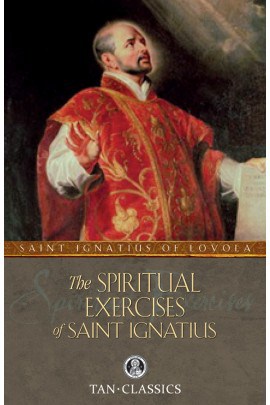"Go forth and set the world on fire," exhorted St. Ignatius of Loyola.
And he practiced what he preached.
His militant example in pursuing virtue, in developing the spiritual exercises, practicing self-denial, educating himself, establishing missions and Jesuit colleges all kindled a blaze whose generative sparks flew far and wide through the work of the order he established, the Society of Jesus. All this and more he accomplished despite frequent sicknesses, humiliations, and even unjust imprisonments, which he embraced as more opportunities to grow in grace.
Born in Spain on Christmas Eve of 1491 to a noble family, he was sent as a youth to the home of a family friend, where he spent many years training as a page. He became a soldier, and as a captain leading the battle against the French at the siege of Pampeluna, his right leg was broken by a cannon ball. Though the French were impressed by his bravery and set the leg before carrying him home to the family castle at Loyola, it healed badly and had to be broken again and reset. Even this second attempt did not heal well, and Ignatius requested that a protruding bone be sawed off, which he endured without complaint, despite the lack of anesthesia. Though his reason for submitting to this horrific procedure was most likely vanity, as he desired a life at court, it proved his ability to suffer pain in silence, which he made frequent use of the rest of his life in order to mortify his flesh.
Accustomed to the exciting life of a soldier, Ignatius grew bored during his long convalescence and requested some romantic books of chivalrous tales. These were not to be found in the household at Loyola, so he was brought books on the life of Christ and the lives of the saints. Into these he plunged and soon realized that when he read them he felt calm and serene and desired to emulate the great deeds of the saints that he had read about, but when he turned his thoughts to a woman to whom he was attracted he felt pleasure at first, but then afterward he felt unhappy. Realizing this difference, he read the books intently and became inflamed with the idea of serving God as a soldier of Christ. This is when he first became aware of the discernment of spirits.
Agonizing over his past sins, he began practicing severe penances, and when his leg had healed, he determined to go on pilgrimage to Jerusalem. He journeyed first to Montserrat, to a shrine of Our Lady, at which place he gave away his fine garments, donned sackcloth, and spent three days preparing his confession, after which he gave up his sword and dagger, hanging them near the altar, and kept vigil there all night. The next morning he took residence in a nearby cave at Manresa where he spent his time in prayer and fasting. As he did many times from this time forward, he lived on alms and practiced mortification. He was troubled greatly by scruples and fought valiantly to be free of them. Finally God relieved him, and he never suffered them again. The understanding of the spiritual life that he gained during this period prompted him to begin making notes, which eventually grew into his book, Spiritual Exercises, a guide of such power and insight into the soul that in his encyclical, Mens Nostra, Pius XI praised it as holding "the foremost place" in works of its type and named Ignatius the patron of all spiritual exercises.
At last in February of 1522 he set off for the Holy Land, only to be sent away from there after a few days by the Franciscan Provincial of the Holy Places. With a keen mind for strategy developed by his military training, he determined that he needed to educate himself in order to best carry out his goals; therefore, he returned to Spain and in Barcelona studied Latin in a boys school, even though he was by then 33-years-old. Learning did not come easily for Ignatius, but he persevered, going wherever he needed to go. After Barcelona he went on to the University of Alcara, then to Salamanca, and finally to Paris, where he was awarded his Master of Arts in 1535. Wherever he traveled, he always worked to teach the faith and to help others in need.
Although he began work on his doctorate, he was unable to finish because of an illness that required him to return to Spain for recovery. His education had been a long and arduous struggle. Later, when he began establishing schools through the Society of Jesus, he was adamant about the students in the Order's schools receiving a thorough liberal arts foundation before going on to higher studies.
While a student in Paris, Ignatius had met the small group of men who would form the beginning of his Society. They began praying together and practicing the spiritual exercises, eventually deciding to take a vow of perpetual poverty and chastity, which they did on the Feast of the Assumption, 1534. Thinking of themselves as a military unit, they called themselves the Company of Jesus and were eager to fight heresy and win souls for Christ. They planned to do so in the Holy Land, though they were prevented from this goal by the war between the Turks and the Venetians and instead offered their services to the pope. These followers of Ignatius had all earned doctorates of theology from the University of Paris, an incalculable asset when in a few years the Company organized itself into the formal religious order that Pope Paul III approved in a bull dated September 27, 1540. It was Pope Paul who changed the name to the Society of Jesus. Ignatius reluctantly accepted the lifetime position of General and wrote the Order's constitutions.
With the schools, colleges, seminaries, and missions that the Society established, the impact on the world is so monumental, it defies calculation. The Order practically exploded out of Rome, growing and spreading so quickly that by the time Ignatius died sixteen years later, it boasted more than 10,000 members, and important schools had been established like the Roman College, the type of all Jesuit colleges. During this same time period, the Jesuits are everywhere credited with being the instruments of the Counter-Reformation.
Ignatius died in Rome at age 65 on July 31, 1556. He was canonized by Gregory XV on May 22, 1622.

